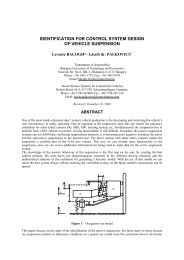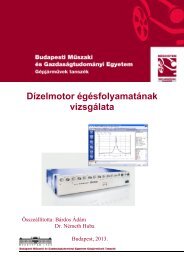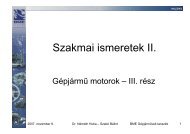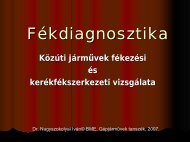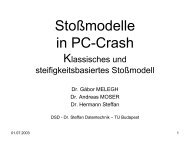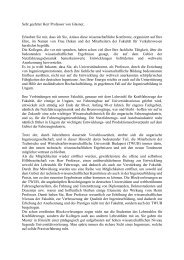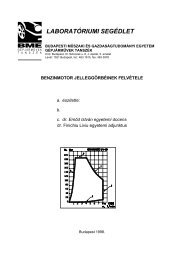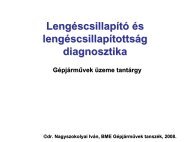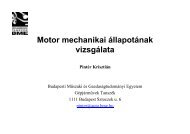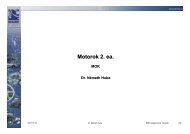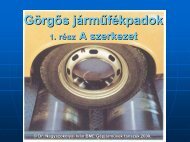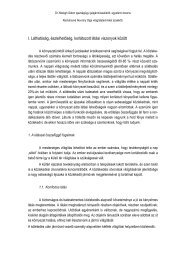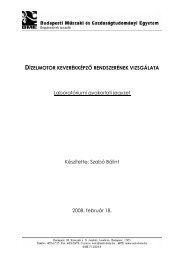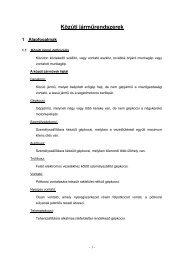Friction in Internal Combustion Engines
Friction in Internal Combustion Engines
Friction in Internal Combustion Engines
You also want an ePaper? Increase the reach of your titles
YUMPU automatically turns print PDFs into web optimized ePapers that Google loves.
Mean friction pressure p mr [bar]<br />
<strong>Friction</strong> <strong>in</strong> <strong>Internal</strong> <strong>Combustion</strong> Eng<strong>in</strong>es<br />
Lecture at the<br />
Budapest University<br />
of Technology and Economics<br />
November 18, 2010<br />
Mean effective pressure p me<br />
[bar]<br />
Prof. Dr.-Ing. Wilhelm Hannibal,<br />
Fachhochschule Südwestfalen,<br />
University of Applied Science,<br />
Iserlohn, Germany<br />
hannibal@fh-swf.de<br />
Copyright: Prof. Dr.-Ing. W. Hannibal, Fachhochschule Südwestfalen, University of Applied Science, Iserlohn, Germany, contact: hannibal@fh-swf.de<br />
Fig. 1
Presentation Outl<strong>in</strong>e<br />
1 Introduction<br />
2 Basic Theoretical Views of <strong>Friction</strong> and Lubrication<br />
3 Methods for Measur<strong>in</strong>g of <strong>Friction</strong> at <strong>Internal</strong> <strong>Combustion</strong> Eng<strong>in</strong>es<br />
4 Influence of <strong>Friction</strong> on the Fuel Consumption<br />
5 <strong>Friction</strong> Behaviour of <strong>Combustion</strong> Eng<strong>in</strong>es Already Built<br />
6 <strong>Friction</strong> of the Valve Tra<strong>in</strong> Components<br />
7 <strong>Friction</strong> of the Eng<strong>in</strong>e Block Components<br />
8 <strong>Friction</strong> of the Auxiliaries<br />
9 Thermo Management<br />
10 Reduction of Idle Speed<br />
11 Reduction of <strong>Friction</strong> Through Variable Valve Tra<strong>in</strong><br />
12 Trends In The Eng<strong>in</strong>e Development to Reduce <strong>Friction</strong><br />
13 Summary / Outlook<br />
Fig. 2<br />
Copyright: Prof. Dr.-Ing. W. Hannibal, Fachhochschule Südwestfalen, University of Applied Science, Iserlohn, Germany, contact: hannibal@fh-swf.de
1 Introduction<br />
Measures to Reduce Fuel Consumption on <strong>Combustion</strong> Eng<strong>in</strong>es<br />
• Optimization of the burn<strong>in</strong>g process<br />
„Better Efficiency“<br />
• Reduction of pump<strong>in</strong>g losses<br />
• Reduction of the eng<strong>in</strong>e´s friction<br />
Source: BMW<br />
Copyright: Prof. Dr.-Ing. W. Hannibal, Fachhochschule Südwestfalen, University of Applied Science, Iserlohn, Germany, contact: hannibal@fh-swf.de
Presentation Outl<strong>in</strong>e<br />
1 Introduction<br />
2 Basic Theoretical Views of <strong>Friction</strong> and Lubrication<br />
3 Methods for Measur<strong>in</strong>g of <strong>Friction</strong> at <strong>Internal</strong> <strong>Combustion</strong> Eng<strong>in</strong>es<br />
4 Influence of <strong>Friction</strong> on the Fuel Consumption<br />
5 <strong>Friction</strong> Behaviour of <strong>Combustion</strong> Eng<strong>in</strong>es Already Built<br />
6 <strong>Friction</strong> of the Valve Tra<strong>in</strong> Components<br />
7 <strong>Friction</strong> of the Eng<strong>in</strong>e Block Components<br />
8 <strong>Friction</strong> of the Auxiliaries<br />
9 Thermo Management<br />
10 Reduction of Idle Speed<br />
11 Reduction of <strong>Friction</strong> Through Variable Valve Tra<strong>in</strong><br />
12 Trends In The Eng<strong>in</strong>e Development to Reduce <strong>Friction</strong><br />
13 Summary / Outlook<br />
Fig. 4<br />
Copyright: Prof. Dr.-Ing. W. Hannibal, Fachhochschule Südwestfalen, University of Applied Science, Iserlohn, Germany, contact: hannibal@fh-swf.de
2 Basic Theoretical Views of <strong>Friction</strong> and Lubrication<br />
Def<strong>in</strong>ition of <strong>Friction</strong><br />
The useful power at the output shaft of <strong>in</strong>ternal combustion<br />
eng<strong>in</strong>es (effective power Pe) is lower than the <strong>in</strong>ternal power<br />
at the pistons (<strong>in</strong>dicated power Pi).<br />
The difference is referred to as the friction loss Pr.<br />
Pr = Pi - Pe<br />
Copyright: Prof. Dr.-Ing. W. Hannibal, Fachhochschule Südwestfalen, University of Applied Science, Iserlohn, Germany, contact: hannibal@fh-swf.de<br />
Fig. 5
2 Basic Theoretical Views of <strong>Friction</strong> and Lubrication<br />
Def<strong>in</strong>ition of <strong>Friction</strong><br />
The friction power is the sum of the friction of all eng<strong>in</strong>e<br />
components like piston friction, valve tra<strong>in</strong> friction, pump friction<br />
etc..<br />
To compare different eng<strong>in</strong>es <strong>in</strong> their efficiency the friction is<br />
summarized <strong>in</strong> the mean friction pressure pmr.<br />
Copyright: Prof. Dr.-Ing. W. Hannibal, Fachhochschule Südwestfalen, University of Applied Science, Iserlohn, Germany, contact: hannibal@fh-swf.de<br />
Fig. 6
2 Basic Theoretical Views of <strong>Friction</strong> and Lubrication<br />
Components that Cause <strong>Friction</strong><br />
The friction of a complete eng<strong>in</strong>e <strong>in</strong>cludes the friction losses or drive powers of the<br />
<strong>in</strong>dividual eng<strong>in</strong>e´s components:<br />
‣ An eng<strong>in</strong>e consist<strong>in</strong>g of:<br />
• Crankshaft ma<strong>in</strong> bear<strong>in</strong>g with radial shaft seal<strong>in</strong>g r<strong>in</strong>gs<br />
• Connection rod bear<strong>in</strong>gs and piston group (pistons, piston r<strong>in</strong>gs and piston p<strong>in</strong>s)<br />
• Any mass balanc<strong>in</strong>g systems<br />
‣ Valve tra<strong>in</strong> and tim<strong>in</strong>g gear<br />
‣ Auxiliaries, such as:<br />
• Oil pump, possibly with oil pump drive<br />
• Coolant pump<br />
• Alternator<br />
• Fuel <strong>in</strong>jection pump<br />
• Radiator fan<br />
• Vacuum pump<br />
• Air condition<strong>in</strong>g Compressor<br />
• Power steer<strong>in</strong>g pump<br />
• Air Compressor<br />
Source: Basshuysen, [2]<br />
Copyright: Prof. Dr.-Ing. W. Hannibal, Fachhochschule Südwestfalen, University of Applied Science, Iserlohn, Germany, contact: hannibal@fh-swf.de<br />
Fig. 7
2 Basic Theoretical Views of <strong>Friction</strong> and Lubrication<br />
<strong>Friction</strong> States<br />
Depend<strong>in</strong>g on lubrication prevail<strong>in</strong>g at the various friction po<strong>in</strong>ts <strong>in</strong> the<br />
eng<strong>in</strong>e, different friction states occur. The most important are:<br />
• Solid friction (Coulomb‘s friction)<br />
<strong>Friction</strong> between solids without fluid <strong>in</strong>termediate layer.<br />
• Boundary friction<br />
<strong>Friction</strong> between solids with an applied solid lubricant layer without a fluid<br />
<strong>in</strong>termediate layer<br />
• Mixed friction<br />
Fluid friction and solid friction or boundary friction occur simultaneously; the<br />
lubricant layer does not completely separate the two friction layers from one<br />
another, and a certa<strong>in</strong> contact occurs.<br />
• Fluid friction (hydrodynamic friction)<br />
A liquid (or gaseous) substance between the two friction layers completely<br />
separates' the two from one another. In the <strong>in</strong>ternal combustion eng<strong>in</strong>e, the<br />
movement of the friction surfaces aga<strong>in</strong>st one another creates the<br />
hydrodynamic support<strong>in</strong>g effect of the <strong>in</strong>termediate substance.<br />
Source: Basshuysen, [2]<br />
Copyright: Prof. Dr.-Ing. W. Hannibal, Fachhochschule Südwestfalen, University of Applied Science, Iserlohn, Germany, contact: hannibal@fh-swf.de<br />
Fig. 8
Coefficient of friction μ<br />
2 Basic Theoretical Views of <strong>Friction</strong> and Lubrication<br />
Stribeck Curve<br />
ν = const.<br />
Start<strong>in</strong>g friction<br />
Boundary friciton<br />
Mixed friction<br />
Breakaway po<strong>in</strong>t<br />
Liquid friction<br />
Lower<br />
operat<strong>in</strong>g limit<br />
Upper<br />
operat<strong>in</strong>g limit<br />
Slid<strong>in</strong>g speed v<br />
- - - - - - - Liquid friction<br />
- - - - - Solid friction<br />
Copyright: Prof. Dr.-Ing. W. Hannibal, Fachhochschule Südwestfalen, University of Applied Science, Iserlohn, Germany, contact: hannibal@fh-swf.de<br />
Source: Affenzeller, [3]<br />
Fig. 9
2 Basic Theoretical Views of <strong>Friction</strong> and Lubrication<br />
The Level of Temperatures at <strong>Combustion</strong> Eng<strong>in</strong>es<br />
180 to 300 C<br />
180 to 300 C<br />
115 to 185 C<br />
Source: Grebe, [4]<br />
80 to to150 C<br />
component s temperature is one of the most friction <strong>in</strong>fluenc<strong>in</strong>g parameters<br />
Copyright: Prof. Dr.-Ing. W. Hannibal, Fachhochschule Südwestfalen, University of Applied Science, Iserlohn, Germany, contact: hannibal@fh-swf.de<br />
Fig. 10
K<strong>in</strong>ematic viscosity <strong>in</strong> [mm 2 / s]<br />
2 Basic Theoretical Views of <strong>Friction</strong> and Lubrication<br />
“Ubbelohe Diagram”<br />
Eng<strong>in</strong>e oil<br />
Temperature [ C]<br />
Copyright: Prof. Dr.-Ing. W. Hannibal, Fachhochschule Südwestfalen, University of Applied Science, Iserlohn, Germany, contact: hannibal@fh-swf.de<br />
Fig. 11
2 Basic Theoretical Views of <strong>Friction</strong> and Lubrication<br />
Temperature Scope of Eng<strong>in</strong>e´s Oil Quality<br />
Temperature<br />
<strong>in</strong> C Source: Grebe, [4]<br />
Copyright: Prof. Dr.-Ing. W. Hannibal, Fachhochschule Südwestfalen, University of Applied Science, Iserlohn, Germany, contact: hannibal@fh-swf.de<br />
Fig. 12
2 Basic Theoretical Views of <strong>Friction</strong> and Lubrication<br />
The Eng<strong>in</strong>e´s Oil Circuit<br />
Ventilation<br />
from eng<strong>in</strong>e to<br />
fuel tank<br />
Stor<strong>in</strong>g<br />
tank<br />
Ventilation to air filter<br />
Full flow filter<br />
oil pressure sensor<br />
Lubrication<br />
(camshaft)<br />
Temperaturesensor<br />
Drills<br />
Oil pressure and<br />
oil temperature<br />
gauge<br />
Oil cooler<br />
With cool<strong>in</strong>g<br />
Without cool<strong>in</strong>g<br />
Source: Grebe, [4]<br />
Pressure relief valve<br />
(opens at 5.4 bar)<br />
Oil pump<br />
Pla<strong>in</strong><br />
oil pan<br />
Pressure relief valve<br />
(opens at 8 bar)<br />
Oil stra<strong>in</strong>er<br />
Oil pump for the recirculation<br />
Copyright: Prof. Dr.-Ing. W. Hannibal, Fachhochschule Südwestfalen, University of Applied Science, Iserlohn, Germany, contact: hannibal@fh-swf.de<br />
Fig. 13
2 Basic Theoretical Views of <strong>Friction</strong> and Lubrication<br />
Pressure Oil Circuit and Oil Back Flow to the Oil Sump<br />
Oil filter<br />
Balance shaft<br />
Oil pump<br />
gear<br />
Duocentric<br />
oil pump<br />
Plate<br />
oil cooler<br />
Pressure oil<br />
course<br />
Oil return l<strong>in</strong>e<br />
Low pressure oil<br />
course Source: Grebe, [4]<br />
Copyright: Prof. Dr.-Ing. W. Hannibal, Fachhochschule Südwestfalen, University of Applied Science, Iserlohn, Germany, contact: hannibal@fh-swf.de<br />
Fig. 14
2 Basic Theoretical Views of <strong>Friction</strong> and Lubrication<br />
Hydro Dynamical Lubrication<br />
Tightened<br />
gap<br />
Copyright: Prof. Dr.-Ing. W. Hannibal, Fachhochschule Südwestfalen, University of Applied Science, Iserlohn, Germany, contact: hannibal@fh-swf.de<br />
Fig. 15
2 Basic Theoretical Views of <strong>Friction</strong> and Lubrication<br />
Shaft Position over Shaft Speed<br />
speed = 0 low speed high speed speed = ∞<br />
Copyright: Prof. Dr.-Ing. W. Hannibal, Fachhochschule Südwestfalen, University of Applied Science, Iserlohn, Germany, contact: hannibal@fh-swf.de<br />
Fig. 16
2 Basic Theoretical Views of <strong>Friction</strong> and Lubrication<br />
Shaft Position Depend<strong>in</strong>g on <strong>Friction</strong> Status<br />
a) Dry friction a) Mixed friction c) Liquid friction<br />
Dry<br />
friction<br />
Liquid<br />
friction<br />
Lubrication<br />
oil<br />
Standstill Low peripheral speed High peripheral speed<br />
Bear<strong>in</strong>g<br />
Bear<strong>in</strong>g<br />
journal<br />
Lubrication<br />
oil<br />
bear<strong>in</strong>g Bear<strong>in</strong>g<br />
force<br />
Liquid<br />
pressure<br />
Copyright: Prof. Dr.-Ing. W. Hannibal, Fachhochschule Südwestfalen, University of Applied Science, Iserlohn, Germany, contact: hannibal@fh-swf.de<br />
Fig. 17
2 Basic Theoretical Views of <strong>Friction</strong> and Lubrication<br />
Influence of the Shaft Bend<strong>in</strong>g on the Bear<strong>in</strong>g Pressure<br />
Copyright: Prof. Dr.-Ing. W. Hannibal, Fachhochschule Südwestfalen, University of Applied Science, Iserlohn, Germany, contact: hannibal@fh-swf.de<br />
Fig. 18
2 Basic Theoretical Views of <strong>Friction</strong> and Lubrication<br />
Influence of the Bend<strong>in</strong>g Geometry on the Bear<strong>in</strong>g Pressure<br />
Copyright: Prof. Dr.-Ing. W. Hannibal, Fachhochschule Südwestfalen, University of Applied Science, Iserlohn, Germany, contact: hannibal@fh-swf.de<br />
Fig. 19
Presentation Outl<strong>in</strong>e<br />
1 Introduction<br />
2 Basic Theoretical Views of <strong>Friction</strong> and Lubrication<br />
3 Methods for Measur<strong>in</strong>g of <strong>Friction</strong> at <strong>Internal</strong> <strong>Combustion</strong> Eng<strong>in</strong>es<br />
4 Influence of <strong>Friction</strong> on the Fuel Consumption<br />
5 <strong>Friction</strong> Behaviour of <strong>Combustion</strong> Eng<strong>in</strong>es Already Built<br />
6 <strong>Friction</strong> of the Valve Tra<strong>in</strong> Components<br />
7 <strong>Friction</strong> of the Eng<strong>in</strong>e Block Components<br />
8 <strong>Friction</strong> of the Auxiliaries<br />
9 Thermo Management<br />
10 Reduction of Idle Speed<br />
11 Reduction of <strong>Friction</strong> Through Variable Valve Tra<strong>in</strong><br />
12 Trends In The Eng<strong>in</strong>e Development to Reduce <strong>Friction</strong><br />
13 Summary / Outlook<br />
Fig. 20<br />
Copyright: Prof. Dr.-Ing. W. Hannibal, Fachhochschule Südwestfalen, University of Applied Science, Iserlohn, Germany, contact: hannibal@fh-swf.de
3 Methods of Measur<strong>in</strong>g <strong>Friction</strong> at <strong>Internal</strong> <strong>Combustion</strong> Eng<strong>in</strong>es<br />
Overview of Methods<br />
- The run down method<br />
- The shutoff method<br />
- The Willians l<strong>in</strong>es<br />
- The motor<strong>in</strong>g method<br />
- The strip method<br />
- The <strong>in</strong>dication method<br />
- Special measur<strong>in</strong>g method<br />
Copyright: Prof. Dr.-Ing. W. Hannibal, Fachhochschule Südwestfalen, University of Applied Science, Iserlohn, Germany, contact: hannibal@fh-swf.de<br />
Fig. 21
3 Methods of Measur<strong>in</strong>g <strong>Friction</strong> at <strong>Internal</strong> <strong>Combustion</strong> Eng<strong>in</strong>es<br />
The Run Down Method<br />
Here the eng<strong>in</strong>e is switched off after stabilization at an operat<strong>in</strong>g<br />
po<strong>in</strong>t, and the change <strong>in</strong> speed is measured as a function of<br />
time. The friction moment or mean friction pressure is then<br />
calculated us<strong>in</strong>g the moments of <strong>in</strong>ertia of the mov<strong>in</strong>g masses.<br />
Copyright: Prof. Dr.-Ing. W. Hannibal, Fachhochschule Südwestfalen, University of Applied Science, Iserlohn, Germany, contact: hannibal@fh-swf.de<br />
Fig. 22
3 Methods of Measur<strong>in</strong>g <strong>Friction</strong> at <strong>Internal</strong> <strong>Combustion</strong> Eng<strong>in</strong>es<br />
The Shutoff Method<br />
On multiple-cyl<strong>in</strong>der eng<strong>in</strong>es, the fuel supply to one of the cyl<strong>in</strong>der<br />
is shut off, and this cyl<strong>in</strong>der is then dragged along by the other<br />
work<strong>in</strong>g cyl<strong>in</strong>ders.<br />
The friction loss can be determ<strong>in</strong>ed from the change <strong>in</strong> effective<br />
eng<strong>in</strong>e power before and after the fuel shutoff.<br />
Copyright: Prof. Dr.-Ing. W. Hannibal, Fachhochschule Südwestfalen, University of Applied Science, Iserlohn, Germany, contact: hannibal@fh-swf.de<br />
Fig. 23
3 Methods of Measur<strong>in</strong>g <strong>Friction</strong> at <strong>Internal</strong> <strong>Combustion</strong> Eng<strong>in</strong>es<br />
The Willians L<strong>in</strong>es<br />
The fuel consumption of an eng<strong>in</strong>e is plotted on the Y-axis aga<strong>in</strong>st<br />
the mean effective pressure p me for various eng<strong>in</strong>e speeds.<br />
The <strong>in</strong>tersections with the negative p me axis are then determ<strong>in</strong>ed<br />
by l<strong>in</strong>ear extrapolation of the values down to fuel consumption<br />
zero; these can be roughly regarded as the mean friction pressure<br />
at the respective eng<strong>in</strong>e speeds.<br />
Copyright: Prof. Dr.-Ing. W. Hannibal, Fachhochschule Südwestfalen, University of Applied Science, Iserlohn, Germany, contact: hannibal@fh-swf.de<br />
Fig. 24
3 Methods of Measur<strong>in</strong>g <strong>Friction</strong> at <strong>Internal</strong> <strong>Combustion</strong> Eng<strong>in</strong>es<br />
The Motor<strong>in</strong>g Method<br />
The eng<strong>in</strong>e is motored on a<br />
test rig by an external motor.<br />
The motor<strong>in</strong>g power<br />
required to drive the eng<strong>in</strong>e<br />
is regarded as the friction<br />
loss. With this method either<br />
the eng<strong>in</strong>e can be motored<br />
at operat<strong>in</strong>g temperature<br />
and measured immediately<br />
after shutt<strong>in</strong>g of the fuel<br />
supply or it can be<br />
conditioned via external<br />
thermostat <strong>in</strong>stallations.<br />
Copyright: Prof. Dr.-Ing. W. Hannibal, Fachhochschule Südwestfalen, University of Applied Science, Iserlohn, Germany, contact: hannibal@fh-swf.de<br />
Fig. 25
3 Methods of Measur<strong>in</strong>g <strong>Friction</strong> at <strong>Internal</strong> <strong>Combustion</strong> Eng<strong>in</strong>es<br />
The Strip Method<br />
Strip measurement is a special form of motor<strong>in</strong>g that is used to<br />
measure the friction losses of the various eng<strong>in</strong>e components, such<br />
as, the friction of the eng<strong>in</strong>e, the valve tra<strong>in</strong>, and the auxiliary drives.<br />
The designation derives from the method where the eng<strong>in</strong>e is<br />
dismantled (stripped) step by step on a motor<strong>in</strong>g test rig.<br />
The friction losses of the <strong>in</strong>dividual components are determ<strong>in</strong>ed from<br />
the difference between the measured values with and without these<br />
components. The total friction of the eng<strong>in</strong>e is obta<strong>in</strong>ed by addition of<br />
the values for the <strong>in</strong>dividual components.<br />
Copyright: Prof. Dr.-Ing. W. Hannibal, Fachhochschule Südwestfalen, University of Applied Science, Iserlohn, Germany, contact: hannibal@fh-swf.de<br />
Fig. 26
3 Methods of Measur<strong>in</strong>g <strong>Friction</strong> at <strong>Internal</strong> <strong>Combustion</strong> Eng<strong>in</strong>es<br />
The Indication Method<br />
This method can be used to<br />
determ<strong>in</strong>e the friction of an<br />
eng<strong>in</strong>e <strong>in</strong> motor<strong>in</strong>g mode.<br />
Integration of the measured<br />
cyl<strong>in</strong>der pressure over a<br />
work<strong>in</strong>g cycle gives the<br />
<strong>in</strong>dicated work W i which<br />
referred to the swept volume,<br />
gives the <strong>in</strong>dicated mean<br />
pressure p mi . If the mean<br />
effective pressure p me<br />
calculated from the torque<br />
measured at the drive shaft is<br />
subtracted from this, we<br />
obta<strong>in</strong> the mean friction<br />
pressure p mr .<br />
Copyright: Prof. Dr.-Ing. W. Hannibal, Fachhochschule Südwestfalen, University of Applied Science, Iserlohn, Germany, contact: hannibal@fh-swf.de<br />
Fig. 27
3 Methods of Measur<strong>in</strong>g <strong>Friction</strong> at <strong>Internal</strong> <strong>Combustion</strong> Eng<strong>in</strong>es<br />
The Cyl<strong>in</strong>der Pressure Transducer<br />
Source: Kistler<br />
Copyright: Prof. Dr.-Ing. W. Hannibal, Fachhochschule Südwestfalen, University of Applied Science, Iserlohn, Germany, contact: hannibal@fh-swf.de<br />
Fig. 28
3 Methods of Measur<strong>in</strong>g <strong>Friction</strong> at <strong>Internal</strong> <strong>Combustion</strong> Eng<strong>in</strong>es<br />
The Cyl<strong>in</strong>der Pressure Indication; Charge Amplifier<br />
Source: Kistler<br />
Copyright: Prof. Dr.-Ing. W. Hannibal, Fachhochschule Südwestfalen, University of Applied Science, Iserlohn, Germany, contact: hannibal@fh-swf.de<br />
Fig. 29
3 Methods of Measur<strong>in</strong>g <strong>Friction</strong> at <strong>Internal</strong> <strong>Combustion</strong> Eng<strong>in</strong>es<br />
The Cyl<strong>in</strong>der Pressure Indication; Data Post Process<strong>in</strong>g<br />
Source: Kistler<br />
Copyright: Prof. Dr.-Ing. W. Hannibal, Fachhochschule Südwestfalen, University of Applied Science, Iserlohn, Germany, contact: hannibal@fh-swf.de<br />
Fig. 30
3 Methods of Measur<strong>in</strong>g <strong>Friction</strong> at <strong>Internal</strong> <strong>Combustion</strong> Eng<strong>in</strong>es<br />
Example of Cyl<strong>in</strong>der Pressure Measurement Equipment<br />
Precleaner<br />
Air<br />
meter<br />
U- bend manometer<br />
Calm<strong>in</strong>g tank<br />
Air filter and flow sensor<br />
plate<br />
Electric fuel pump Tank<br />
Flow divider Filter<br />
Air<br />
Fuel <strong>in</strong>jectors<br />
Return flow<br />
cool<strong>in</strong>g<br />
Consumption measur<strong>in</strong>g<br />
Radiator<br />
Oil filter<br />
Control pressure Generator<br />
Torque measur<strong>in</strong>g<br />
Heater<br />
Crankshaft<br />
mark<br />
Light barrier<br />
Oil cooler<br />
Exhaust<br />
silencer<br />
External<br />
oil pump<br />
Oscillo<br />
-scope<br />
P1- meter<br />
Voltmeter<br />
Eng<strong>in</strong>e<br />
speed<br />
measur<strong>in</strong>g<br />
Thermocouple<br />
Pressure sensor<br />
Source: Hannibal, [1]<br />
Gas meter<br />
Meter<strong>in</strong>g po<strong>in</strong>t<br />
Heater<br />
Oil pressure<br />
Copyright: Prof. Dr.-Ing. W. Hannibal, Fachhochschule Südwestfalen, University of Applied Science, Iserlohn, Germany, contact: hannibal@fh-swf.de<br />
Fig. 31
3 Methods of Measur<strong>in</strong>g <strong>Friction</strong> at <strong>Internal</strong> <strong>Combustion</strong> Eng<strong>in</strong>es<br />
p mi Defect Because of an Incorrect TDC Trigger Signal<br />
After TDC Trigger pulse Before TDC<br />
Source: Hannibal, [1]<br />
Copyright: Prof. Dr.-Ing. W. Hannibal, Fachhochschule Südwestfalen, University of Applied Science, Iserlohn, Germany, contact: hannibal@fh-swf.de<br />
Fig. 32
3 Methods of Measur<strong>in</strong>g <strong>Friction</strong> at <strong>Internal</strong> <strong>Combustion</strong> Eng<strong>in</strong>es<br />
The Cyl<strong>in</strong>der Pressure Indication; Piston Position Adjustment<br />
Piston Stroke Measurement<br />
Groove disk<br />
Eng<strong>in</strong>e block<br />
Crank shaft mark<br />
Oscilloscope<br />
b. TDC TDC a.TDC<br />
Bulb<br />
Digital Voltmeter<br />
PI Meter<br />
Phototransistor<br />
Source: Hannibal, [1]<br />
Copyright: Prof. Dr.-Ing. W. Hannibal, Fachhochschule Südwestfalen, University of Applied Science, Iserlohn, Germany, contact: hannibal@fh-swf.de<br />
Fig. 33
3 Methods of Measur<strong>in</strong>g <strong>Friction</strong> at <strong>Internal</strong> <strong>Combustion</strong> Eng<strong>in</strong>es<br />
Example for Oil Temperature Condition<strong>in</strong>g<br />
1 Eng<strong>in</strong>e<br />
2 Compensation<br />
reservoir<br />
3 Oil pump<br />
4 Valve<br />
5 Valve<br />
7 Coolant reservoir<br />
8 Feed valve<br />
9 Discharge valve<br />
10 Over fall<br />
11 Oil heat<strong>in</strong>g<br />
12 Manometer<br />
13 Oil filter<br />
Source: Hannibal, [1]<br />
Copyright: Prof. Dr.-Ing. W. Hannibal, Fachhochschule Südwestfalen, University of Applied Science, Iserlohn, Germany, contact: hannibal@fh-swf.de<br />
Fig. 34
3 Methods of Measur<strong>in</strong>g <strong>Friction</strong> at <strong>Internal</strong> <strong>Combustion</strong> Eng<strong>in</strong>es<br />
Example for Water Temperature Condition<strong>in</strong>g<br />
1 Eng<strong>in</strong>e<br />
2 Coolant reservoir<br />
3 Feed valve<br />
4 Discharge valve<br />
5 Over fall<br />
6 Coolant heat<strong>in</strong>g<br />
7 Water pump<br />
Source: Hannibal, [1]<br />
Copyright: Prof. Dr.-Ing. W. Hannibal, Fachhochschule Südwestfalen, University of Applied Science, Iserlohn, Germany, contact: hannibal@fh-swf.de<br />
Fig. 35
3 Methods of Measur<strong>in</strong>g <strong>Friction</strong> at <strong>Internal</strong> <strong>Combustion</strong> Eng<strong>in</strong>es<br />
Special Measur<strong>in</strong>g Method<br />
Apart from the friction measur<strong>in</strong>g methods described above,<br />
there are a large number of other methods for determ<strong>in</strong><strong>in</strong>g,<br />
for example, the friction of <strong>in</strong>dividual components dur<strong>in</strong>g<br />
operation. Torque measur<strong>in</strong>g flanges can be used to carry<br />
out measurements on components driven by shafts. For the<br />
piston group there are various facilities for measur<strong>in</strong>g the<br />
piston frictional force.<br />
Copyright: Prof. Dr.-Ing. W. Hannibal, Fachhochschule Südwestfalen, University of Applied Science, Iserlohn, Germany, contact: hannibal@fh-swf.de<br />
Fig. 36
3 Methods of Measur<strong>in</strong>g <strong>Friction</strong> at <strong>Internal</strong> <strong>Combustion</strong> Eng<strong>in</strong>es<br />
Comparison of the Individual <strong>Friction</strong> Measurement Methods<br />
Copyright: Prof. Dr.-Ing. W. Hannibal, Fachhochschule Südwestfalen, University of Applied Science, Iserlohn, Germany, contact: hannibal@fh-swf.de<br />
Source: Basshuysen, [2]<br />
Fig. 37
Presentation Outl<strong>in</strong>e<br />
1 Introduction<br />
2 Basic Theoretical Views of <strong>Friction</strong> and Lubrication<br />
3 Methods for Measur<strong>in</strong>g of <strong>Friction</strong> at <strong>Internal</strong> <strong>Combustion</strong> Eng<strong>in</strong>es<br />
4 Influence of <strong>Friction</strong> on the Fuel Consumption<br />
5 <strong>Friction</strong> Behaviour of <strong>Combustion</strong> Eng<strong>in</strong>es Already Built<br />
6 <strong>Friction</strong> of the Valve Tra<strong>in</strong> Components<br />
7 <strong>Friction</strong> of the Eng<strong>in</strong>e Block Components<br />
8 <strong>Friction</strong> of the Auxiliaries<br />
9 Thermo Management<br />
10 Reduction of Idle Speed<br />
11 Reduction of <strong>Friction</strong> Through Variable Valve Tra<strong>in</strong><br />
12 Trends In The Eng<strong>in</strong>e Development to Reduce <strong>Friction</strong><br />
13 Summary / Outlook<br />
Fig. 38<br />
Copyright: Prof. Dr.-Ing. W. Hannibal, Fachhochschule Südwestfalen, University of Applied Science, Iserlohn, Germany, contact: hannibal@fh-swf.de
4 Influence of <strong>Friction</strong> on the Fuel Consumption<br />
Comparison between Diesel and Spark Ignition Eng<strong>in</strong>es<br />
The mechanical efficiency η m of an <strong>in</strong>ternal combustion eng<strong>in</strong>e<br />
is def<strong>in</strong>ed as the ratio of mean effective pressure p me to mean<br />
<strong>in</strong>dicated pressure p mi .<br />
To compare different eng<strong>in</strong>es <strong>in</strong> their efficiency the friction is<br />
summarized <strong>in</strong> the mean effective friction pressure pmr.<br />
At an eng<strong>in</strong>e speed of 2000 rpm p mr has values between 0.5<br />
and 1.4 bar <strong>in</strong>clud<strong>in</strong>g <strong>in</strong>jection pump and all eng<strong>in</strong>e components.<br />
Copyright: Prof. Dr.-Ing. W. Hannibal, Fachhochschule Südwestfalen, University of Applied Science, Iserlohn, Germany, contact: hannibal@fh-swf.de<br />
Fig. 39
Mean friction pressure p mr [bar]<br />
4 Influence of <strong>Friction</strong> on the Fuel Consumption<br />
Comparison between Diesel and Spark Ignition Eng<strong>in</strong>es<br />
Complete eng<strong>in</strong>e<br />
Motor, valve tra<strong>in</strong><br />
loaded oil pump,<br />
Loaded water pump<br />
Unloaded alternator<br />
Motored, full load<br />
Oil: 15W40<br />
Oil/Coolant temperature: 90 C<br />
Spark ignition eng<strong>in</strong>e<br />
Diesel eng<strong>in</strong>e (direct <strong>in</strong>jection)<br />
Eng<strong>in</strong>e speed [1/m<strong>in</strong>] Source: Koch, [5]<br />
Copyright: Prof. Dr.-Ing. W. Hannibal, Fachhochschule Südwestfalen, University of Applied Science, Iserlohn, Germany, contact: hannibal@fh-swf.de<br />
Fig. 40
Mean friction pressure p mr [bar]<br />
4 Influence of <strong>Friction</strong> on the Fuel Consumption<br />
Development of the <strong>Friction</strong> <strong>in</strong> Four Cyl<strong>in</strong>der SI-Eng<strong>in</strong>es<br />
Source: Schwaderlapp, [6]<br />
Model year<br />
4-cyl<strong>in</strong>der SI eng<strong>in</strong>es<br />
(1.6 to 2.2 liter piston displacement)<br />
Copyright: Prof. Dr.-Ing. W. Hannibal, Fachhochschule Südwestfalen, University of Applied Science, Iserlohn, Germany, contact: hannibal@fh-swf.de<br />
Fig. 41
Reduction of fuel consumption<br />
4 Influence of <strong>Friction</strong> on the Fuel Consumption<br />
Comparison between Diesel and Spark Ignition Eng<strong>in</strong>es<br />
Diesel eng<strong>in</strong>e<br />
Spark<br />
ignition<br />
eng<strong>in</strong>e<br />
Reduction of friction<br />
Source: Koch, [7]<br />
Copyright: Prof. Dr.-Ing. W. Hannibal, Fachhochschule Südwestfalen, University of Applied Science, Iserlohn, Germany, contact: hannibal@fh-swf.de<br />
Fig. 42
Power [%]<br />
4 Influence of <strong>Friction</strong> on the Fuel Consumption<br />
Percentages of <strong>Friction</strong> losses <strong>in</strong> the Eng<strong>in</strong>e Characteristic Map<br />
Eng<strong>in</strong>e speed [1/m<strong>in</strong>]<br />
Source: FEV<br />
Copyright: Prof. Dr.-Ing. W. Hannibal, Fachhochschule Südwestfalen, University of Applied Science, Iserlohn, Germany, contact: hannibal@fh-swf.de<br />
Fig. 43
Presentation Outl<strong>in</strong>e<br />
1 Introduction<br />
2 Basic Theoretical Views of <strong>Friction</strong> and Lubrication<br />
3 Methods for Measur<strong>in</strong>g of <strong>Friction</strong> at <strong>Internal</strong> <strong>Combustion</strong> Eng<strong>in</strong>es<br />
4 Influence of <strong>Friction</strong> on the Fuel Consumption<br />
5 <strong>Friction</strong> Behaviour of <strong>Combustion</strong> Eng<strong>in</strong>es Already Built<br />
6 <strong>Friction</strong> of the Valve Tra<strong>in</strong> Components<br />
7 <strong>Friction</strong> of the Eng<strong>in</strong>e Block Components<br />
8 <strong>Friction</strong> of the Auxiliaries<br />
9 Thermo Management<br />
10 Reduction of Idle Speed<br />
11 Reduction of <strong>Friction</strong> Through Variable Valve Tra<strong>in</strong><br />
12 Trends In The Eng<strong>in</strong>e Development to Reduce <strong>Friction</strong><br />
13 Summary / Outlook<br />
Fig. 44<br />
Copyright: Prof. Dr.-Ing. W. Hannibal, Fachhochschule Südwestfalen, University of Applied Science, Iserlohn, Germany, contact: hannibal@fh-swf.de
Mean friciton friction pressure p mr [bar]<br />
5 <strong>Friction</strong> Behaviour of <strong>Combustion</strong> Eng<strong>in</strong>es Already Built<br />
<strong>Friction</strong> Breakdown of a Modern Car SI Eng<strong>in</strong>e<br />
Water pump<br />
and alternator<br />
Oil pump<br />
Valve tra<strong>in</strong><br />
Pistons and piston rods<br />
Crankshaft<br />
Eng<strong>in</strong>e speed [1/m<strong>in</strong>]<br />
Oil: SAE 15W40<br />
Oil/coolant<br />
temperature: 90 C<br />
Source: Koch, [7]<br />
Copyright: Prof. Dr.-Ing. W. Hannibal, Fachhochschule Südwestfalen, University of Applied Science, Iserlohn, Germany, contact: hannibal@fh-swf.de<br />
Fig. 45
Percentage [%]<br />
5 <strong>Friction</strong> Behaviour of <strong>Combustion</strong> Eng<strong>in</strong>es Already Built<br />
Percentage Breakdown of <strong>Friction</strong> <strong>in</strong> a Modern Car SI Eng<strong>in</strong>e<br />
auxiliaries<br />
valve tra<strong>in</strong><br />
piston group<br />
crank shaft<br />
Eng<strong>in</strong>e speed [rpm]<br />
Source: Grebe, [4]<br />
Copyright: Prof. Dr.-Ing. W. Hannibal, Fachhochschule Südwestfalen, University of Applied Science, Iserlohn, Germany, contact: hannibal@fh-swf.de<br />
Fig. 46
Mean friciton pressure p mr [bar]<br />
5 <strong>Friction</strong> Behaviour of <strong>Combustion</strong> Eng<strong>in</strong>es Already Built<br />
Percentage Breakdown of <strong>Friction</strong> <strong>in</strong> a Modern Car SI Eng<strong>in</strong>e<br />
Power steer<strong>in</strong>g pump<br />
A/C compressor unloaded<br />
Fuel Pump<br />
Water pump and alternator<br />
Oil Pump<br />
Valve Tra<strong>in</strong><br />
Pistons and piston rods<br />
Eng<strong>in</strong>e speed [1/m<strong>in</strong>]<br />
Crankshaft<br />
Oil: SAE 15W50<br />
Oil/Coolant<br />
Temperature: 90 C<br />
Source: Koch, [7]<br />
Copyright: Prof. Dr.-Ing. W. Hannibal, Fachhochschule Südwestfalen, University of Applied Science, Iserlohn, Germany, contact: hannibal@fh-swf.de<br />
Fig. 47
Mean friction friciton pressure p mr mr [bar]<br />
5 <strong>Friction</strong> Behaviour of <strong>Combustion</strong> Eng<strong>in</strong>es Already Built<br />
<strong>Friction</strong> <strong>in</strong> Car Eng<strong>in</strong>es as a function of Swept Volume<br />
Complete eng<strong>in</strong>e<br />
(stripped)<br />
motor, valve tra<strong>in</strong><br />
loaded oil pump,<br />
loaded water pump<br />
unloaded alternator<br />
e<strong>in</strong>fügen<br />
Oil: SAE 15W50<br />
Oil/Coolant temperature:<br />
90 C<br />
Piston displacment [cm³]<br />
Source: Basshuysen, [2]<br />
Copyright: Prof. Dr.-Ing. W. Hannibal, Fachhochschule Südwestfalen, University of Applied Science, Iserlohn, Germany, contact: hannibal@fh-swf.de<br />
Fig. 48
Mean friciton pressure @ 2000 rpm [bar]<br />
5 <strong>Friction</strong> Behaviour of <strong>Combustion</strong> Eng<strong>in</strong>es Already Built<br />
p mr Benchmark from Model Year 1998 - 2008<br />
FEV Benchmark 2009<br />
Model year<br />
Source: FEV<br />
Copyright: Prof. Dr.-Ing. W. Hannibal, Fachhochschule Südwestfalen, University of Applied Science, Iserlohn, Germany, contact: hannibal@fh-swf.de<br />
Fig. 49
Mean friction pressure p mr [bar]<br />
5 <strong>Friction</strong> Behaviour of <strong>Combustion</strong> Eng<strong>in</strong>es Already Built<br />
<strong>Friction</strong> Measurement Results from a 1.8l SI Four Cyl<strong>in</strong>der Eng<strong>in</strong>e<br />
Mean effective pressure p me<br />
[bar]<br />
Source: Hannibal, [1]<br />
Copyright: Prof. Dr.-Ing. W. Hannibal, Fachhochschule Südwestfalen, University of Applied Science, Iserlohn, Germany, contact: hannibal@fh-swf.de<br />
Fig. 50
5 <strong>Friction</strong> Behaviour of <strong>Combustion</strong> Eng<strong>in</strong>es Already Built<br />
<strong>Friction</strong> Measurement Results from a 1.8l SI Four Cyl<strong>in</strong>der Eng<strong>in</strong>e<br />
p mr [bar] Temperature T [ C]<br />
Mean effective pressure p me<br />
[bar]<br />
Source: Hannibal, [1]<br />
Copyright: Prof. Dr.-Ing. W. Hannibal, Fachhochschule Südwestfalen, University of Applied Science, Iserlohn, Germany, contact: hannibal@fh-swf.de<br />
Fig. 51
Temperature T [ C]<br />
p mr [bar]<br />
5 <strong>Friction</strong> Behaviour of <strong>Combustion</strong> Eng<strong>in</strong>es Already Built<br />
<strong>Friction</strong> Measurement Results from a 1.8l SI Four Cyl<strong>in</strong>der Eng<strong>in</strong>e<br />
Mean effective pressure p me<br />
[bar]<br />
Source: Hannibal, [1]<br />
Copyright: Prof. Dr.-Ing. W. Hannibal, Fachhochschule Südwestfalen, University of Applied Science, Iserlohn, Germany, contact: hannibal@fh-swf.de<br />
Fig. 52
p mr [bar]<br />
Temperature T [ C]<br />
5 <strong>Friction</strong> Behaviour of <strong>Combustion</strong> Eng<strong>in</strong>es Already Built<br />
<strong>Friction</strong> Measurement Results from a 1.8l SI Four Cyl<strong>in</strong>der Eng<strong>in</strong>e<br />
Mean effective pressure p me<br />
[bar]<br />
Source: Hannibal, [1]<br />
Copyright: Prof. Dr.-Ing. W. Hannibal, Fachhochschule Südwestfalen, University of Applied Science, Iserlohn, Germany, contact: hannibal@fh-swf.de<br />
Fig. 53
Blow by Q B [m n ³/h] Blow by rate Q BR [x100 <strong>in</strong> %]<br />
5 <strong>Friction</strong> Behaviour of <strong>Combustion</strong> Eng<strong>in</strong>es Already Built<br />
<strong>Friction</strong> Measurement Results from a 1.8l SI Four Cyl<strong>in</strong>der Eng<strong>in</strong>e<br />
Mean effective pressure p me [bar] Source: Hannibal, [1]<br />
Copyright: Prof. Dr.-Ing. W. Hannibal, Fachhochschule Südwestfalen, University of Applied Science, Iserlohn, Germany, contact: hannibal@fh-swf.de<br />
Fig. 54
p mr [bar] Temperature T [ C]<br />
5 <strong>Friction</strong> Behaviour of <strong>Combustion</strong> Eng<strong>in</strong>es Already Built<br />
<strong>Friction</strong> Measurement Results from a 1.8l SI Four Cyl<strong>in</strong>der Eng<strong>in</strong>e<br />
Eng<strong>in</strong>e speed [1/m<strong>in</strong>]<br />
T Oil =90 C T WE =80 C<br />
Copyright: Prof. Dr.-Ing. W. Hannibal, Fachhochschule Südwestfalen, University of Applied Science, Iserlohn, Germany, contact: hannibal@fh-swf.de<br />
Source: Hannibal, [1]<br />
Fig. 55
p mr [bar]<br />
5 <strong>Friction</strong> Behaviour of <strong>Combustion</strong> Eng<strong>in</strong>es Already Built<br />
<strong>Friction</strong> Measurement Results from a 1.8l SI Four Cyl<strong>in</strong>der Eng<strong>in</strong>e<br />
Mean effective pressure p me<br />
[bar]<br />
Source: Hannibal, [1]<br />
Copyright: Prof. Dr.-Ing. W. Hannibal, Fachhochschule Südwestfalen, University of Applied Science, Iserlohn, Germany, contact: hannibal@fh-swf.de<br />
Fig. 56
5 <strong>Friction</strong> Behaviour of <strong>Combustion</strong> Eng<strong>in</strong>es Already Built<br />
<strong>Friction</strong> Measurement Results from a 1.8l SI Four Cyl<strong>in</strong>der Eng<strong>in</strong>e<br />
p mr [bar] Temperature T [ C]<br />
Coolant Temp. T WE [ C]<br />
T oil =90 C<br />
Source: Hannibal, [1]<br />
Copyright: Prof. Dr.-Ing. W. Hannibal, Fachhochschule Südwestfalen, University of Applied Science, Iserlohn, Germany, contact: hannibal@fh-swf.de<br />
Fig. 57
p mr [bar] Temperature T [ C]<br />
5 <strong>Friction</strong> Behaviour of <strong>Combustion</strong> Eng<strong>in</strong>es Already Built<br />
<strong>Friction</strong> Measurement Results from a 1.8l SI Four Cyl<strong>in</strong>der Eng<strong>in</strong>e<br />
Coolant Temp. T WE [ C]<br />
T oil =90 C<br />
Source: Hannibal, [1]<br />
Copyright: Prof. Dr.-Ing. W. Hannibal, Fachhochschule Südwestfalen, University of Applied Science, Iserlohn, Germany, contact: hannibal@fh-swf.de<br />
Fig. 58
Mean friction pressure p mr [bar]<br />
5 <strong>Friction</strong> Behaviour of <strong>Combustion</strong> Eng<strong>in</strong>es Already Built<br />
Comparison of Measured Mean <strong>Friction</strong> Pressures<br />
Oil/Coolant temperature = 90 C<br />
Fired eng<strong>in</strong>e, variation of load<br />
Fired eng<strong>in</strong>e, zero load<br />
Motor<strong>in</strong>g mode<br />
Mean effective pressure p me [bar]<br />
Source: Basshuysen, [2]<br />
Copyright: Prof. Dr.-Ing. W. Hannibal, Fachhochschule Südwestfalen, University of Applied Science, Iserlohn, Germany, contact: hannibal@fh-swf.de<br />
Fig. 59
5 <strong>Friction</strong> Behaviour of <strong>Combustion</strong> Eng<strong>in</strong>es Already Built<br />
Influence of the Oil Viscosity on <strong>Friction</strong><br />
Source: Basshuysen, [2]<br />
Copyright: Prof. Dr.-Ing. W. Hannibal, Fachhochschule Südwestfalen, University of Applied Science, Iserlohn, Germany, contact: hannibal@fh-swf.de<br />
Fig. 60
5 <strong>Friction</strong> Behaviour of <strong>Combustion</strong> Eng<strong>in</strong>es Already Built<br />
Oil Pressure and Oil Volumetric Flow <strong>in</strong> the Lubrication Circuit<br />
Source: Basshuysen, [2]<br />
Copyright: Prof. Dr.-Ing. W. Hannibal, Fachhochschule Südwestfalen, University of Applied Science, Iserlohn, Germany, contact: hannibal@fh-swf.de<br />
Fig. 61
Presentation Outl<strong>in</strong>e<br />
1 Introduction<br />
2 Basic Theoretical Views of <strong>Friction</strong> and Lubrication<br />
3 Methods for Measur<strong>in</strong>g of <strong>Friction</strong> at <strong>Internal</strong> <strong>Combustion</strong> Eng<strong>in</strong>es<br />
4 Influence of <strong>Friction</strong> on the Fuel Consumption<br />
5 <strong>Friction</strong> Behaviour of <strong>Combustion</strong> Eng<strong>in</strong>es Already Built<br />
6 <strong>Friction</strong> of the Valve Tra<strong>in</strong> Components<br />
7 <strong>Friction</strong> of the Eng<strong>in</strong>e Block Components<br />
8 <strong>Friction</strong> of the Auxiliaries<br />
9 Thermo Management<br />
10 Reduction of Idle Speed<br />
11 Reduction of <strong>Friction</strong> Through Variable Valve Tra<strong>in</strong><br />
12 Trends In The Eng<strong>in</strong>e Development to Reduce <strong>Friction</strong><br />
13 Summary / Outlook<br />
Fig. 62<br />
Copyright: Prof. Dr.-Ing. W. Hannibal, Fachhochschule Südwestfalen, University of Applied Science, Iserlohn, Germany, contact: hannibal@fh-swf.de
Mean friction pressure [bar]<br />
6 <strong>Friction</strong> of the Valve Tra<strong>in</strong> Components<br />
<strong>Friction</strong> for Several Valve Tra<strong>in</strong> Concepts<br />
Mechanical lash adjustment <strong>in</strong> Comparison<br />
to roller rocker f<strong>in</strong>ger<br />
Bucket with hydraulically lash adjustment 1.6 l – 4V (Gen. 2)<br />
<strong>Friction</strong> range hydraulic buckets<br />
<strong>Friction</strong> range roller rocker f<strong>in</strong>ger<br />
Example for a<br />
bucket with<br />
mechanical lash<br />
adjustment<br />
Eng<strong>in</strong>e speed [1/m<strong>in</strong>]<br />
Source: Grebe, [4]<br />
Copyright: Prof. Dr.-Ing. W. Hannibal, Fachhochschule Südwestfalen, University of Applied Science, Iserlohn, Germany, contact: hannibal@fh-swf.de<br />
Fig. 63
6 <strong>Friction</strong> of the Valve Tra<strong>in</strong> Components<br />
Bucket Valve Tra<strong>in</strong><br />
Hollow<br />
camshaft<br />
Bucket with<br />
mechanical lash<br />
adjustment<br />
Conical<br />
valve spr<strong>in</strong>g<br />
Example: GM Powertra<strong>in</strong> 1,6l – 4V Tw<strong>in</strong>port Source: Grebe, [4]<br />
Copyright: Prof. Dr.-Ing. W. Hannibal, Fachhochschule Südwestfalen, University of Applied Science, Iserlohn, Germany, contact: hannibal@fh-swf.de<br />
Fig. 64
Torque [Nm]<br />
6 <strong>Friction</strong> of the Valve Tra<strong>in</strong> Components<br />
Torque at the Camshaft<br />
Total camshaft torque<br />
<strong>Friction</strong>al torque<br />
Torque<br />
0 CA<br />
Torque drives cam<br />
Camshaft angle [ CA]<br />
Source: Grebe, [4]<br />
Copyright: Prof. Dr.-Ing. W. Hannibal, Fachhochschule Südwestfalen, University of Applied Science, Iserlohn, Germany, contact: hannibal@fh-swf.de<br />
Fig. 65
6 <strong>Friction</strong> of the Valve Tra<strong>in</strong> Components<br />
Comparison of Various Valve Tra<strong>in</strong> Concepts<br />
Source: Koch, [5]<br />
Copyright: Prof. Dr.-Ing. W. Hannibal, Fachhochschule Südwestfalen, University of Applied Science, Iserlohn, Germany, contact: hannibal@fh-swf.de<br />
Fig. 66
Mean friction pressure [bar]<br />
6 <strong>Friction</strong> of the Valve Tra<strong>in</strong> Components<br />
Breakdown of <strong>Friction</strong> <strong>in</strong> the Valve Tra<strong>in</strong><br />
Bucket<br />
Leightweight<br />
construction<br />
Camshaft bear<strong>in</strong>gs<br />
Valve guide<br />
Bucket guide<br />
EHD contact<br />
Roller bear<strong>in</strong>gs<br />
Eng<strong>in</strong>e speed [1/m<strong>in</strong>]<br />
Source: Speckens, [8]<br />
Copyright: Prof. Dr.-Ing. W. Hannibal, Fachhochschule Südwestfalen, University of Applied Science, Iserlohn, Germany, contact: hannibal@fh-swf.de<br />
Fig. 67
Driv<strong>in</strong>g torque of the cyl<strong>in</strong>der head [Nm]<br />
6 <strong>Friction</strong> of the Valve Tra<strong>in</strong> Components<br />
Influence of Coat<strong>in</strong>gs<br />
4Cyl.-4Valve (94) (Bucket)<br />
Optimised (97) (roll)<br />
Ion- emplanted (98) (roll)<br />
Eng<strong>in</strong>e speed<br />
[1/m<strong>in</strong>]<br />
Source: Goedeckmeyer, [8]<br />
Copyright: Prof. Dr.-Ing. W. Hannibal, Fachhochschule Südwestfalen, University of Applied Science, Iserlohn, Germany, contact: hannibal@fh-swf.de<br />
Fig. 68
6 <strong>Friction</strong> of the Valve Tra<strong>in</strong> Components<br />
Roller Contact To The Cam at the Levers<br />
Roller<br />
rocker<br />
f<strong>in</strong>ger<br />
Roller<br />
rocker<br />
arm<br />
Copyright: Prof. Dr.-Ing. W. Hannibal, Fachhochschule Südwestfalen, University of Applied Science, Iserlohn, Germany, contact: hannibal@fh-swf.de<br />
Fig. 69
6 <strong>Friction</strong> of the Valve Tra<strong>in</strong> Components<br />
DLC-Diamant Coat<strong>in</strong>g<br />
Hard, diamond like<br />
surface coat<strong>in</strong>g,<br />
mostly applied <strong>in</strong> PVD<br />
(physical vapor deposition).<br />
Direct <strong>in</strong>fluence on the<br />
friction surface.<br />
DLC coat- thickness 5 μm.<br />
Approximately 5 %<br />
reduction of friction<br />
Source: Grebe, [4]<br />
Copyright: Prof. Dr.-Ing. W. Hannibal, Fachhochschule Südwestfalen, University of Applied Science, Iserlohn, Germany, contact: hannibal@fh-swf.de<br />
Fig. 70
6 <strong>Friction</strong> of the Valve Tra<strong>in</strong> Components<br />
…<br />
Built camshaft with<br />
needle bear<strong>in</strong>gs.<br />
Needles run directly on<br />
the hardened camshaft.<br />
Valves and valve spr<strong>in</strong>gs<br />
unaltered for the measur<strong>in</strong>g<br />
Source: Grebe, [4]<br />
Copyright: Prof. Dr.-Ing. W. Hannibal, Fachhochschule Südwestfalen, University of Applied Science, Iserlohn, Germany, contact: hannibal@fh-swf.de<br />
Fig. 71
Presentation Outl<strong>in</strong>e<br />
1 Introduction<br />
2 Basic Theoretical Views of <strong>Friction</strong> and Lubrication<br />
3 Methods for Measur<strong>in</strong>g of <strong>Friction</strong> at <strong>Internal</strong> <strong>Combustion</strong> Eng<strong>in</strong>es<br />
4 Influence of <strong>Friction</strong> on the Fuel Consumption<br />
5 <strong>Friction</strong> Behaviour of <strong>Combustion</strong> Eng<strong>in</strong>es Already Built<br />
6 <strong>Friction</strong> of the Valve Tra<strong>in</strong> Components<br />
7 <strong>Friction</strong> of the Eng<strong>in</strong>e Block Components<br />
8 <strong>Friction</strong> of the Auxiliaries<br />
9 Thermo Management<br />
10 Reduction of Idle Speed<br />
11 Reduction of <strong>Friction</strong> Through Variable Valve Tra<strong>in</strong><br />
12 Trends In The Eng<strong>in</strong>e Development to Reduce <strong>Friction</strong><br />
13 Summary / Outlook<br />
Fig. 72<br />
Copyright: Prof. Dr.-Ing. W. Hannibal, Fachhochschule Südwestfalen, University of Applied Science, Iserlohn, Germany, contact: hannibal@fh-swf.de
Ma<strong>in</strong> bear<strong>in</strong>g friction moment [Nm]<br />
7 <strong>Friction</strong> of the Eng<strong>in</strong>e Block and its Components<br />
<strong>Friction</strong> per Crankshaft Ma<strong>in</strong> Bear<strong>in</strong>g Over Ma<strong>in</strong> Bear<strong>in</strong>g Diameter<br />
Ma<strong>in</strong> bear<strong>in</strong>g diameter [mm]<br />
e<strong>in</strong>fügen<br />
2000 rpm<br />
Oil: SAE 15W50<br />
Oil/Coolant<br />
temperature: 90 C<br />
Regression curve<br />
for SI eng<strong>in</strong>es<br />
Regression curve<br />
for diesel eng<strong>in</strong>es<br />
Regression curve<br />
for SI R eng<strong>in</strong>es<br />
Ma<strong>in</strong> bear<strong>in</strong>g diameter³ [cm³]<br />
Source: Pisch<strong>in</strong>ger, [9];<br />
Koch, [5]<br />
Copyright: Prof. Dr.-Ing. W. Hannibal, Fachhochschule Südwestfalen, University of Applied Science, Iserlohn, Germany, contact: hannibal@fh-swf.de<br />
Fig. 73
Dynamic friction force [N]<br />
7 <strong>Friction</strong> of the Eng<strong>in</strong>e Block and its Components<br />
<strong>Friction</strong> …<br />
Dynamic friction force measur<strong>in</strong>g system - PIFFO<br />
Piston friction force<br />
Piston r<strong>in</strong>g Package:<br />
Version B: Basic Version<br />
Version C: Optimized pretension<br />
and r<strong>in</strong>g height<br />
Motored, full load<br />
2000 rpm<br />
Oil/coolant<br />
temperature: 90 C<br />
100<br />
Version C<br />
0<br />
-200<br />
Version B<br />
-100<br />
Source: Koch, [7]<br />
0 180 360 540 720<br />
Crankshaft angle [degree]<br />
Copyright: Prof. Dr.-Ing. W. Hannibal, Fachhochschule Südwestfalen, University of Applied Science, Iserlohn, Germany, contact: hannibal@fh-swf.de<br />
Fig. 74
Mean friction pressure [bar]<br />
7 <strong>Friction</strong> of the Eng<strong>in</strong>e Block and its Components<br />
<strong>Friction</strong> …<br />
Piston r<strong>in</strong>gs variants: 1, 2, 3, 4<br />
Boundary conditions: Trailed, full load<br />
Temperature 90 C<br />
Source: Koch, [5]<br />
Sum of piston r<strong>in</strong>g surfaces pressure<br />
Copyright: Prof. Dr.-Ing. W. Hannibal, Fachhochschule Südwestfalen, University of Applied Science, Iserlohn, Germany, contact: hannibal@fh-swf.de<br />
Fig. 75
7 <strong>Friction</strong> of the Eng<strong>in</strong>e Block and its Components<br />
Ma<strong>in</strong> Influence Parameter of the Crankshaft Component <strong>Friction</strong><br />
Number of r<strong>in</strong>gs<br />
and tangential<br />
tension<br />
Mass of piston<br />
and piston rod<br />
Glid<strong>in</strong>g surface<br />
at the side<br />
Bear<strong>in</strong>g diameter<br />
Source: Grebe, [4]<br />
Copyright: Prof. Dr.-Ing. W. Hannibal, Fachhochschule Südwestfalen, University of Applied Science, Iserlohn, Germany, contact: hannibal@fh-swf.de<br />
Fig. 76
7 <strong>Friction</strong> of the Eng<strong>in</strong>e Block and its Components<br />
Locations of <strong>Friction</strong> at the Piston Group<br />
Piston r<strong>in</strong>gs<br />
Piston<br />
Piston<br />
p<strong>in</strong> clip<br />
Source: Grebe, [4]<br />
Piston p<strong>in</strong><br />
Piston rod bear<strong>in</strong>g<br />
Small piston<br />
rod eye<br />
Piston rod<br />
Piston rod<br />
screw<br />
Piston rod<br />
bear<strong>in</strong>g<br />
Large piston<br />
rod eye<br />
Piston rod<br />
bear<strong>in</strong>g cap<br />
Copyright: Prof. Dr.-Ing. W. Hannibal, Fachhochschule Südwestfalen, University of Applied Science, Iserlohn, Germany, contact: hannibal@fh-swf.de<br />
Fig. 77
7 <strong>Friction</strong> of the Eng<strong>in</strong>e Block and its Components<br />
<strong>Friction</strong> …<br />
Source: Grebe, [4]<br />
Fly Wheel<br />
Crank Arm<br />
Shaft Extension<br />
(Mean Bear<strong>in</strong>g)<br />
Crank Shaft<br />
Crank bow<br />
Crank Shaft<br />
Journal<br />
Starter Gear R<strong>in</strong>g<br />
Axial bear<strong>in</strong>g disc<br />
Crank Shaft<br />
Bear<strong>in</strong>g Shells<br />
Copyright: Prof. Dr.-Ing. W. Hannibal, Fachhochschule Südwestfalen, University of Applied Science, Iserlohn, Germany, contact: hannibal@fh-swf.de<br />
Fig. 78
7 <strong>Friction</strong> of the Eng<strong>in</strong>e Block and its Components<br />
K<strong>in</strong>ematic Situation at the Piston Group<br />
Source: Grebe, [4]<br />
Piston Lateral<br />
Force F N<br />
<strong>Combustion</strong><br />
Pressure p<br />
Piston Force F K<br />
Connection Rod<br />
Force F P<br />
Radial Force F R<br />
Tangential Force<br />
F T<br />
r: Crank Radius<br />
M: Eng<strong>in</strong>e Torque<br />
Connection Rod<br />
Force F P<br />
Copyright: Prof. Dr.-Ing. W. Hannibal, Fachhochschule Südwestfalen, University of Applied Science, Iserlohn, Germany, contact: hannibal@fh-swf.de<br />
Fig. 79
7 <strong>Friction</strong> of the Eng<strong>in</strong>e Block and its Components<br />
<strong>Friction</strong> …<br />
Compression Pressure<br />
<strong>Combustion</strong> Pressure<br />
TDC<br />
CA<br />
CA<br />
CA<br />
DS: Pressure<br />
Site GDS: Backpressure Site<br />
Axis set off<br />
Source: Grebe, [4]<br />
Copyright: Prof. Dr.-Ing. W. Hannibal, Fachhochschule Südwestfalen, University of Applied Science, Iserlohn, Germany, contact: hannibal@fh-swf.de<br />
Fig. 80
7 <strong>Friction</strong> of the Eng<strong>in</strong>e Block and its Components<br />
Cyl<strong>in</strong>der Bore Wear; Normal Wear Left, Ahead Time Wear Right<br />
TDC<br />
Reversal po<strong>in</strong>t<br />
Region of<br />
high piston<br />
velocity<br />
Source: Grebe, [4]<br />
Copyright: Prof. Dr.-Ing. W. Hannibal, Fachhochschule Südwestfalen, University of Applied Science, Iserlohn, Germany, contact: hannibal@fh-swf.de<br />
Fig. 81
7 <strong>Friction</strong> of the Eng<strong>in</strong>e Block and its Components<br />
…<br />
Cyl<strong>in</strong>der Wall<br />
Hydro dynamical<br />
Pressure<br />
Piston<br />
Lateral<br />
Force<br />
Lubrication Gap<br />
Piston<br />
Source: Grebe, [4]<br />
Copyright: Prof. Dr.-Ing. W. Hannibal, Fachhochschule Südwestfalen, University of Applied Science, Iserlohn, Germany, contact: hannibal@fh-swf.de<br />
Fig. 82
<strong>Friction</strong> Torque<br />
0.25 Nm<br />
0.1 bar<br />
7 <strong>Friction</strong> of the Eng<strong>in</strong>e Block and its Components<br />
Influence of Roller Bear<strong>in</strong>g of the Crankshaft<br />
2000 rpm, 90 C<br />
Roller bear<strong>in</strong>g<br />
Radial shaft seal<br />
Ma<strong>in</strong> bear<strong>in</strong>g diameter [mm]<br />
2000 rpm<br />
Plan bear<strong>in</strong>g<br />
Roller bear<strong>in</strong>g<br />
p me<br />
-72 % -55%<br />
-41%<br />
Oil Temperature [ C]<br />
Source: Grebe, [4]<br />
Copyright: Prof. Dr.-Ing. W. Hannibal, Fachhochschule Südwestfalen, University of Applied Science, Iserlohn, Germany, contact: hannibal@fh-swf.de<br />
Fig. 83
Presentation Outl<strong>in</strong>e<br />
1 Introduction<br />
2 Basic Theoretical Views of <strong>Friction</strong> and Lubrication<br />
3 Methods for Measur<strong>in</strong>g of <strong>Friction</strong> at <strong>Internal</strong> <strong>Combustion</strong> Eng<strong>in</strong>es<br />
4 Influence of <strong>Friction</strong> on the Fuel Consumption<br />
5 <strong>Friction</strong> Behaviour of <strong>Combustion</strong> Eng<strong>in</strong>es Already Built<br />
6 <strong>Friction</strong> of the Valve Tra<strong>in</strong> Components<br />
7 <strong>Friction</strong> of the Eng<strong>in</strong>e Block Components<br />
8 <strong>Friction</strong> of the Auxiliaries<br />
9 Thermo Management<br />
10 Reduction of Idle Speed<br />
11 Reduction of <strong>Friction</strong> Through Variable Valve Tra<strong>in</strong><br />
12 Trends In The Eng<strong>in</strong>e Development to Reduce <strong>Friction</strong><br />
13 Summary / Outlook<br />
Fig. 84<br />
Copyright: Prof. Dr.-Ing. W. Hannibal, Fachhochschule Südwestfalen, University of Applied Science, Iserlohn, Germany, contact: hannibal@fh-swf.de
Mean friction pressure p mr [bar]<br />
8 <strong>Friction</strong> of the Auxiliaries<br />
<strong>Friction</strong> of the Auxiliaries Necessary for the Eng<strong>in</strong>e Operation<br />
Scatter Range<br />
Serial gasol<strong>in</strong>e<br />
eng<strong>in</strong>e<br />
Date: 1/2003-1/2009<br />
Number of Eng<strong>in</strong>es: 53<br />
Oil: 0W30 – 15W40<br />
Temperature: 90 C<br />
Auxiliaries:<br />
loaded oil pump<br />
loaded water pump<br />
unloaded alternator<br />
(each <strong>in</strong>cl. drive)<br />
Eng<strong>in</strong>e speed [m<strong>in</strong> -1 ]<br />
Source: FEV<br />
Copyright: Prof. Dr.-Ing. W. Hannibal, Fachhochschule Südwestfalen, University of Applied Science, Iserlohn, Germany, contact: hannibal@fh-swf.de<br />
Fig. 85
Mean friciton pressure p mr [bar]<br />
8 <strong>Friction</strong> of the Auxiliaries<br />
<strong>Friction</strong> of Various Oil Pumps<br />
Oil: 15W40<br />
Oil/Coolant<br />
temperature:<br />
90 C<br />
Oil pump<br />
loaded oil pump,<br />
control valve<br />
(active),<br />
pump drive<br />
Eng<strong>in</strong>e speed [m<strong>in</strong> -1 ]<br />
Source: Basshuysen, [2]<br />
Copyright: Prof. Dr.-Ing. W. Hannibal, Fachhochschule Südwestfalen, University of Applied Science, Iserlohn, Germany, contact: hannibal@fh-swf.de<br />
Fig. 86
8 <strong>Friction</strong> of the Auxiliaries<br />
Oil Pressure and Oil Volumetric Flow <strong>in</strong> the Lubrication Circuit<br />
Source: Basshuysen, [2]<br />
Copyright: Prof. Dr.-Ing. W. Hannibal, Fachhochschule Südwestfalen, University of Applied Science, Iserlohn, Germany, contact: hannibal@fh-swf.de<br />
Fig. 87
Mean friction pressure p me [bar]<br />
8 <strong>Friction</strong> of the Auxiliaries<br />
Level of Several Eng<strong>in</strong>e Components<br />
Eng<strong>in</strong>e 1<br />
Condition<strong>in</strong>g circumstances<br />
Lubricant-/Coolant temp. 90 C<br />
Water pump<br />
Camshaft drive<br />
Valve tra<strong>in</strong><br />
Piston group<br />
Oil pump<br />
Crank<br />
shaft<br />
Eng<strong>in</strong>e speed [1/m<strong>in</strong>]<br />
Eng<strong>in</strong>e speed [1/m<strong>in</strong>]<br />
Copyright: Prof. Dr.-Ing. W. Hannibal, Fachhochschule Südwestfalen, University of Applied Science, Iserlohn, Germany, contact: hannibal@fh-swf.de<br />
Fig. 88
Presentation Outl<strong>in</strong>e<br />
1 Introduction<br />
2 Basic Theoretical Views of <strong>Friction</strong> and Lubrication<br />
3 Methods for Measur<strong>in</strong>g of <strong>Friction</strong> at <strong>Internal</strong> <strong>Combustion</strong> Eng<strong>in</strong>es<br />
4 Influence of <strong>Friction</strong> on the Fuel Consumption<br />
5 <strong>Friction</strong> Behaviour of <strong>Combustion</strong> Eng<strong>in</strong>es Already Built<br />
6 <strong>Friction</strong> of the Valve Tra<strong>in</strong> Components<br />
7 <strong>Friction</strong> of the Eng<strong>in</strong>e Block Components<br />
8 <strong>Friction</strong> of the Auxiliaries<br />
9 Thermo Management<br />
10 Reduction of Idle Speed<br />
11 Reduction of <strong>Friction</strong> Through Variable Valve Tra<strong>in</strong><br />
12 Trends In The Eng<strong>in</strong>e Development to Reduce <strong>Friction</strong><br />
13 Summary / Outlook<br />
Fig. 89<br />
Copyright: Prof. Dr.-Ing. W. Hannibal, Fachhochschule Südwestfalen, University of Applied Science, Iserlohn, Germany, contact: hannibal@fh-swf.de
9 Thermo Management<br />
Components of the Control Circuit<br />
1 Eng<strong>in</strong>e block<br />
2 Cyl<strong>in</strong>der head<br />
3 Mechanical ma<strong>in</strong><br />
cool<strong>in</strong>g pump<br />
4 Cool<strong>in</strong>g control<br />
valve<br />
5 Cooler<br />
6 Eng<strong>in</strong>e cool<strong>in</strong>g<br />
van with jalousie<br />
7 Heat<strong>in</strong>g<br />
recuperator<br />
8 Additional water<br />
pump<br />
9 Check valve<br />
10 Eng<strong>in</strong>e<br />
electronically<br />
control unit (ECU)<br />
Copyright: Prof. Dr.-Ing. W. Hannibal, Fachhochschule Südwestfalen, University of Applied Science, Iserlohn, Germany, contact: hannibal@fh-swf.de<br />
Fig. 90
9 Thermo Management<br />
Example of a Control Circuit<br />
Source: Grebe, [4]<br />
Copyright: Prof. Dr.-Ing. W. Hannibal, Fachhochschule Südwestfalen, University of Applied Science, Iserlohn, Germany, contact: hannibal@fh-swf.de<br />
Fig. 91
9 Thermo Management<br />
Water Flow<br />
Transfers <strong>in</strong> the<br />
head gasket<br />
Water jacket <strong>in</strong><br />
the cyl<strong>in</strong>der head<br />
Thermostat<br />
electrically<br />
heated<br />
Water<br />
pump<br />
Water jacket <strong>in</strong><br />
the cyl<strong>in</strong>der block<br />
Water manifold<br />
Source: Grebe, [4]<br />
Copyright: Prof. Dr.-Ing. W. Hannibal, Fachhochschule Südwestfalen, University of Applied Science, Iserlohn, Germany, contact: hannibal@fh-swf.de<br />
Fig. 92
9 Thermo Management<br />
Influence on Fuel Consumption <strong>in</strong> the Test Cycles<br />
Copyright: Prof. Dr.-Ing. W. Hannibal, Fachhochschule Südwestfalen, University of Applied Science, Iserlohn, Germany, contact: hannibal@fh-swf.de<br />
Source: Grebe, [4]<br />
Fig. 93
9 Thermo Management<br />
Work<strong>in</strong>g Pr<strong>in</strong>ciple<br />
Work<strong>in</strong>g Pr<strong>in</strong>ciple<br />
Electrically heated thermostat allows eng<strong>in</strong>e characteristics<br />
controlled open<strong>in</strong>g of the thermostat<br />
Part load<br />
• High temperature of the cool<strong>in</strong>g fluid (ca. 105-110 C)<br />
• High oil temperature, as the heat transfer is reduced by the<br />
cool<strong>in</strong>g water<br />
• viscosity of the oil decreases → reduced friction<br />
Full load<br />
• maximal cool<strong>in</strong>g for the frigid cyl<strong>in</strong>der head<br />
→ optimized boundary conditions for the eng<strong>in</strong>e knock<strong>in</strong>g<br />
→ maximized cyl<strong>in</strong>der charg<strong>in</strong>g<br />
Copyright: Prof. Dr.-Ing. W. Hannibal, Fachhochschule Südwestfalen, University of Applied Science, Iserlohn, Germany, contact: hannibal@fh-swf.de<br />
Fig. 94
9 Thermo Management<br />
Range of 70 % Mechanical Effiency<br />
4 Stroke SI Eng<strong>in</strong>e<br />
MVEG- Test Circle Relevant Range<br />
Source:<br />
Average mechanical<br />
efficiency: 70%<br />
Copyright: Prof. Dr.-Ing. W. Hannibal, Fachhochschule Südwestfalen, University of Applied Science, Iserlohn, Germany, contact: hannibal@fh-swf.de<br />
Fig. 95
9 Thermo Management<br />
…<br />
Empirical Formula<br />
effective work on the clutch<br />
<strong>in</strong>dicated work on the piston<br />
Empirical Formula (Goetz AG)<br />
specific fuel consumption [g/kWh]<br />
lower<strong>in</strong>g specific fuel consumption [g/kWh]<br />
mechanical efficiency [-]<br />
mean friction pressure [bar]<br />
lower<strong>in</strong>g mean friction pressure [bar]<br />
With an average mechanical efficiency of 0.7<br />
→ 0.05 bar chang<strong>in</strong>g <strong>in</strong> mean friction pressure (at p mr = 1.5 bar)<br />
→ causes 1 % <strong>in</strong> the efficiency / fuel consumption<br />
Copyright: Prof. Dr.-Ing. W. Hannibal, Fachhochschule Südwestfalen, University of Applied Science, Iserlohn, Germany, contact: hannibal@fh-swf.de<br />
Fig. 96
Presentation Outl<strong>in</strong>e<br />
1 Introduction<br />
2 Basic Theoretical Views of <strong>Friction</strong> and Lubrication<br />
3 Methods for Measur<strong>in</strong>g of <strong>Friction</strong> at <strong>Internal</strong> <strong>Combustion</strong> Eng<strong>in</strong>es<br />
4 Influence of <strong>Friction</strong> on the Fuel Consumption<br />
5 <strong>Friction</strong> Behaviour of <strong>Combustion</strong> Eng<strong>in</strong>es Already Built<br />
6 <strong>Friction</strong> of the Valve Tra<strong>in</strong> Components<br />
7 <strong>Friction</strong> of the Eng<strong>in</strong>e Block Components<br />
8 <strong>Friction</strong> of the Auxiliaries<br />
9 Thermo Management<br />
10 Reduction of Idle Speed<br />
11 Reduction of <strong>Friction</strong> Through Variable Valve Tra<strong>in</strong><br />
12 Trends In The Eng<strong>in</strong>e Development to Reduce <strong>Friction</strong><br />
13 Summary / Outlook<br />
Fig. 97<br />
Copyright: Prof. Dr.-Ing. W. Hannibal, Fachhochschule Südwestfalen, University of Applied Science, Iserlohn, Germany, contact: hannibal@fh-swf.de
10 Reduction of Idle Speed<br />
Fuel Consumption Potential<br />
Reduc<strong>in</strong>g the idl<strong>in</strong>g speed decreases fuel consumption<br />
Rule of thumb:<br />
Reduction of 100 1/m<strong>in</strong> results:<br />
SI eng<strong>in</strong>e<br />
0.04 l/h per 1000 cm³ cubic capacity<br />
Diesel eng<strong>in</strong>e<br />
0.022 l/h per 1000 cm³ cubic capacity<br />
Source: Grebe, [4]<br />
Copyright: Prof. Dr.-Ing. W. Hannibal, Fachhochschule Südwestfalen, University of Applied Science, Iserlohn, Germany, contact: hannibal@fh-swf.de<br />
Fig. 98
Idle fuel consumption [l / h / 1000 cm³]<br />
10 Reduction of Idle Speed<br />
Idle Speed Influence<br />
Otto eng<strong>in</strong>es<br />
Diesel eng<strong>in</strong>es<br />
Idle speed<br />
[1/m<strong>in</strong>]<br />
Source: Grebe, [4]<br />
Copyright: Prof. Dr.-Ing. W. Hannibal, Fachhochschule Südwestfalen, University of Applied Science, Iserlohn, Germany, contact: hannibal@fh-swf.de<br />
Fig. 99
10 Reduction of Idle Speed<br />
Limits<br />
• <strong>Combustion</strong> System<br />
- Otto eng<strong>in</strong>e with exterior fuel- mixture generation allows ca. 500 – 600 1/m<strong>in</strong><br />
- fuel direct <strong>in</strong>jection allows lower idl<strong>in</strong>g speeds due to more stable mixture<br />
generation and more accurate admeasurement<br />
• Oil Pump Dimension<strong>in</strong>g<br />
- Oil pressure has to be assured ( eventually larger oil pump with higher <strong>in</strong>put<br />
power)<br />
• Vehicle- Auxiliaries Drive System<br />
- alternator limits the idl<strong>in</strong>g speed reduction<br />
(further improvements through lower mass <strong>in</strong>ertia, decoupl<strong>in</strong>g elements, …)<br />
- control assembly – dynamic<br />
• Driveaway of the Vehicle<br />
- eng<strong>in</strong>e speed is necessary for the clutch- <strong>in</strong> process (clutch modulation)<br />
Copyright: Prof. Dr.-Ing. W. Hannibal, Fachhochschule Südwestfalen, University of Applied Science, Iserlohn, Germany, contact: hannibal@fh-swf.de<br />
Fig. 100
Presentation Outl<strong>in</strong>e<br />
1 Introduction<br />
2 Basic Theoretical Views of <strong>Friction</strong> and Lubrication<br />
3 Methods for Measur<strong>in</strong>g of <strong>Friction</strong> at <strong>Internal</strong> <strong>Combustion</strong> Eng<strong>in</strong>es<br />
4 Influence of <strong>Friction</strong> on the Fuel Consumption<br />
5 <strong>Friction</strong> Behaviour of <strong>Combustion</strong> Eng<strong>in</strong>es Already Built<br />
6 <strong>Friction</strong> of the Valve Tra<strong>in</strong> Components<br />
7 <strong>Friction</strong> of the Eng<strong>in</strong>e Block Components<br />
8 <strong>Friction</strong> of the Auxiliaries<br />
9 Thermo Management<br />
10 Reduction of Idle Speed<br />
11 Reduction of <strong>Friction</strong> Through Variable Valve Tra<strong>in</strong><br />
12 Trends In The Eng<strong>in</strong>e Development to Reduce <strong>Friction</strong><br />
13 Summary / Outlook<br />
Fig. 101<br />
Copyright: Prof. Dr.-Ing. W. Hannibal, Fachhochschule Südwestfalen, University of Applied Science, Iserlohn, Germany, contact: hannibal@fh-swf.de
11 Reduction of <strong>Friction</strong> Through Variable Valve Tra<strong>in</strong><br />
Fully Variable Valve Tra<strong>in</strong> UniValve of Kolbenschmidt Pierburg AG<br />
spr<strong>in</strong>g<br />
guide<br />
'<br />
cam<br />
eccentric shaft<br />
<strong>in</strong>take valve<br />
work<strong>in</strong>g curve<br />
forked lever<br />
roller rocker f<strong>in</strong>ger<br />
HLA<br />
Source: Hannibal, [10]<br />
Copyright: Prof. Dr.-Ing. W. Hannibal, Fachhochschule Südwestfalen, University of Applied Science, Iserlohn, Germany, contact: hannibal@fh-swf.de<br />
Fig. 102
11 Reduction of <strong>Friction</strong> Through Variable Valve Tra<strong>in</strong><br />
<strong>Friction</strong> of the Variable Valve Tra<strong>in</strong> UniValve at Low Speeds<br />
Source: Hannibal, [10]<br />
Copyright: Prof. Dr.-Ing. W. Hannibal, Fachhochschule Südwestfalen, University of Applied Science, Iserlohn, Germany, contact: hannibal@fh-swf.de<br />
Fig. 103
11 Reduction of <strong>Friction</strong> Through Variable Valve Tra<strong>in</strong><br />
<strong>Friction</strong> of the Variable Valve Tra<strong>in</strong> UniValve at Low Speeds<br />
Source: Hannibal, [4]<br />
Copyright: Prof. Dr.-Ing. W. Hannibal, Fachhochschule Südwestfalen, University of Applied Science, Iserlohn, Germany, contact: hannibal@fh-swf.de<br />
Fig. 104
Presentation Outl<strong>in</strong>e<br />
1 Introduction<br />
2 Basic Theoretical Views of <strong>Friction</strong> and Lubrication<br />
3 Methods for Measur<strong>in</strong>g of <strong>Friction</strong> at <strong>Internal</strong> <strong>Combustion</strong> Eng<strong>in</strong>es<br />
4 Influence of <strong>Friction</strong> on the Fuel Consumption<br />
5 <strong>Friction</strong> Behaviour of <strong>Combustion</strong> Eng<strong>in</strong>es Already Built<br />
6 <strong>Friction</strong> of the Valve Tra<strong>in</strong> Components<br />
7 <strong>Friction</strong> of the Eng<strong>in</strong>e Block Components<br />
8 <strong>Friction</strong> of the Auxiliaries<br />
9 Thermo Management<br />
10 Reduction of Idle Speed<br />
11 Reduction of <strong>Friction</strong> Through Variable Valve Tra<strong>in</strong><br />
12 Trends In The Eng<strong>in</strong>e Development to Reduce <strong>Friction</strong><br />
13 Summary / Outlook<br />
Fig. 105<br />
Copyright: Prof. Dr.-Ing. W. Hannibal, Fachhochschule Südwestfalen, University of Applied Science, Iserlohn, Germany, contact: hannibal@fh-swf.de
12 Trends <strong>in</strong> the Eng<strong>in</strong>e Development to Reduce <strong>Friction</strong><br />
- Better analysis methods, usage of data basis<br />
- Reduction of contact surfaces<br />
- Downsiz<strong>in</strong>g<br />
- Usage of roller contacts<br />
- Optimisation of the lubrication system<br />
- Optimisation of the oil quality<br />
- Innovative optimized components like cha<strong>in</strong> tensioners etc.<br />
- …<br />
Copyright: Prof. Dr.-Ing. W. Hannibal, Fachhochschule Südwestfalen, University of Applied Science, Iserlohn, Germany, contact: hannibal@fh-swf.de<br />
Fig. 106
Presentation Outl<strong>in</strong>e<br />
1 Introduction<br />
2 Basic Theoretical Views of <strong>Friction</strong> and Lubrication<br />
3 Methods for Measur<strong>in</strong>g of <strong>Friction</strong> at <strong>Internal</strong> <strong>Combustion</strong> Eng<strong>in</strong>es<br />
4 Influence of <strong>Friction</strong> on the Fuel Consumption<br />
5 <strong>Friction</strong> Behaviour of <strong>Combustion</strong> Eng<strong>in</strong>es Already Built<br />
6 <strong>Friction</strong> of the Valve Tra<strong>in</strong> Components<br />
7 <strong>Friction</strong> of the Eng<strong>in</strong>e Block Components<br />
8 <strong>Friction</strong> of the Auxiliaries<br />
9 Thermo Management<br />
10 Reduction of Idle Speed<br />
11 Reduction of <strong>Friction</strong> Through Variable Valve Tra<strong>in</strong><br />
12 Trends In The Eng<strong>in</strong>e Development to Reduce <strong>Friction</strong><br />
13 Summary / Outlook<br />
Fig. 107<br />
Copyright: Prof. Dr.-Ing. W. Hannibal, Fachhochschule Südwestfalen, University of Applied Science, Iserlohn, Germany, contact: hannibal@fh-swf.de
13 Summary / Outlook<br />
References <strong>in</strong> Addition to the Sources <strong>in</strong> the Slides<br />
- The reduction of friction is a ma<strong>in</strong> development task for achiev<strong>in</strong>g a better<br />
fuel consumption<br />
- all eng<strong>in</strong>e's components have to be optimized<br />
- The standard valve tra<strong>in</strong> will have roller rocker f<strong>in</strong>gers<br />
- The best variable valve tra<strong>in</strong> system will also be based on a roller rocker<br />
f<strong>in</strong>ger design<br />
- The downsiz<strong>in</strong>g concepts will reduce friction thought a consequent light<br />
weight design<br />
- The potential of friction reduction of the eng<strong>in</strong>e block components has to be<br />
a ma<strong>in</strong> topic <strong>in</strong> the eng<strong>in</strong>e development<br />
- The friction reduction of the auxiliaries like optimised oil pumps is also<br />
significant<br />
- A high political pressure on the CO2 potential reduction will speed up the<br />
eng<strong>in</strong>e´s development<br />
Copyright: Prof. Dr.-Ing. W. Hannibal, Fachhochschule Südwestfalen, University of Applied Science, Iserlohn, Germany, contact: hannibal@fh-swf.de<br />
Fig. 108
13 Summary / Outlook<br />
References <strong>in</strong> Addition to the Sources <strong>in</strong> the Slides<br />
[1] Hannibal, W.: Reibungsmessungen an e<strong>in</strong>em schnelllaufenden 4-Takt-Ottomotor. Diplomarbeit, Universität Hannover, 1986<br />
[2] Basshuysen, R.; Schäfer, F.: <strong>Internal</strong> <strong>Combustion</strong>. Handbook, SAE InternationalWarrendale, Pa., 2004<br />
[3] Affenzeller, J.; Gläser, H.: Lagerung und Schmierung von Verbrennungsmotoren: Die Verbrennungskraftmasch<strong>in</strong>e.<br />
Band 8, Spr<strong>in</strong>ger- Verlag, 1996<br />
[4] Grebe, P.: Weiterentwicklung des Ottomotors. Vorlesung an der TU Wien, 2010<br />
[5] Koch, F.; Hermsen, F.; Marckwardt, H.; Haubner, F.: <strong>Friction</strong> Losses of <strong>Combustion</strong> Eng<strong>in</strong>es – Measurements,<br />
Analysis and Optimization <strong>Internal</strong> <strong>Combustion</strong> Eng<strong>in</strong>es Experiments and Model<strong>in</strong>g. Capri, Italy, 15. - 18. 09.1999<br />
[6] Schwaderlapp, M.; Koch, F.; Bollig, C.; Hermsen, F.; Arndt, M: Leichtbau und Reibungsreduzierung – Konstruktive<br />
Potenziale zur Erfüllung von Verbrauchzielen. 21. Internationales Wiener Motorensymposium, Vienna, 04. – 05.05.2000<br />
[7] Koch, F.; Geiger, U.; Hermsen, F.: PIFFO – Piston <strong>Friction</strong> Force Measurement Dur<strong>in</strong>g Eng<strong>in</strong>e Operation. SAE<br />
Paper 960306, 1996<br />
[8] Speckens, F.; Hermsen, F.; Buck, J.: Konstruktive Wege zum reibungsarmen Ventiltrieb. MTZ 59, 1998<br />
[9] Pisch<strong>in</strong>ger, R.; Kraßnig, G.; Taucar, G.; Sams, T.: Thermodynamik der Verbrennungskraftmasch<strong>in</strong>e: Die<br />
Verbrennungskraftmasch<strong>in</strong>e. Band 5, Spr<strong>in</strong>ger- Verlag, 1989<br />
[10] Hannibal, W,; Flierl, F.; Schmitt, S.; Lauer, F.: Schopp, G.; Kle<strong>in</strong>ert, G.: E<strong>in</strong>satz teilvariabler und vollvariabler<br />
Ventilsteuerungen für unterschiedliche Ottomotorenkonzepte. Vortrag auf der 3. ATZ-MTZ Tagung , Ladungswechsel im<br />
Verbrennungsmotor, 19. Oktober 2010, Stuttgart<br />
[11] Goedeckmeyer, S.; W<strong>in</strong>disch, H.: Reibleistungsmessungen an Zyl<strong>in</strong>derköpfen mittels Drehmomentenmessung mit dem<br />
Drehmoment-Meßflansch; Firma HBM, MSR 06/1998<br />
Additional References:<br />
[12] Albers, A.: Konstruktionselemente des Masch<strong>in</strong>enbaus 2. Vorlesungsskript Universität Karlsruhe, 2008<br />
[13] Bartz, W.: Grundlagen der Tribologie. Essl<strong>in</strong>gen, 2002<br />
[14] Kochanovsky, H.: Der Totpunktfehler bei der Bestimmung des <strong>in</strong>dizierten Mitteldruckes von Verbrennungskraftmotoren.<br />
MTZ 37 (1976) 1/2<br />
[15] Ullrich, W.: E<strong>in</strong>fluss des Totpunktfehlers auf die Bestimmung des <strong>in</strong>dizierten Mitteldrucks. Ingolstadt, 1983<br />
[16] Szengel, R.: E<strong>in</strong>fluss konstruktiver Parameter auf die Reibungsverluste der Kolbengruppe e<strong>in</strong>es Hubkolbentriebwerkes.<br />
Dissertation, Universität Hannover, 1985<br />
[17] Paland, E.: Hydrodynamische Gleitlager. Vorlesungsskript Universität Hannover, 1984<br />
Copyright: Prof. Dr.-Ing. W. Hannibal, Fachhochschule Südwestfalen, University of Applied Science, Iserlohn, Germany, contact: hannibal@fh-swf.de<br />
Fig. 109
13 Summary / Outlook<br />
General References <strong>in</strong> Addition to the Sources <strong>in</strong> the Slides<br />
[18] Huber, K.: Reibungsarmer Verbrennungsmotor. Vortrag KKK, 1996<br />
[19] Affenzeller, J. : Lagerung und Schmierung von Verbrennungsmotoren - Die Verbrennungskraftmasch<strong>in</strong>e. Spr<strong>in</strong>ger, 1996<br />
[20] Koch, F.; Haubner, F.; Schwaderlapp, M.: Thermomanagement beim DI Ottomotor – Wege zur Verkürzung des<br />
Warmlaufs. 22. Internationales Wiener Motorensymposium, Vienna, 26.04 - 27.04.2000<br />
[21] Koch, F.; Geiger U.: Reibungsanalyse der Kolbengruppe im gefeuerten Motorbetrieb. GfT Tribologie- Fachtagung,<br />
Gött<strong>in</strong>gen, 5/6 November 1996<br />
[22] Haas, A.: Aufteilung der Triebwerksverluste am schnellaufenden Verbrennungsmotor mittels e<strong>in</strong>es neuen<br />
Messverfahrens. RWTH Aachen, Dissertation, 1987<br />
[23] Koch, F.; Fahl, E.; Haas, A.: A New Technique for Measur<strong>in</strong>g the Bore Distortion Dur<strong>in</strong>g Eng<strong>in</strong>e Operation. 21st<br />
International CIMAC Congress, Interlaken, 1995<br />
[24] Haas, A.; Esch, T.; Fahl, E.;Kreuter P.; Pisch<strong>in</strong>ger, F.: Optimized Design of the Lubrication System of Modern<br />
<strong>Combustion</strong> Eng<strong>in</strong>es. SAE Paper 912407, 1991<br />
[25] Haas, A.; Fahl, E.; Esch, T.: Ölpumpen für e<strong>in</strong>e Verlustarme Motorschmierung. Tagung ‘‘Nebenaggregate im<br />
Fahrzeug‘‘, Essen, 1992<br />
[26] Haas, A.; Kreuter, P.; Maassen, F.: Measurement and Analysis of the Requirement of the Dynamical Bear<strong>in</strong>gs <strong>in</strong> High<br />
Speed Eng<strong>in</strong>es. SIA Nr. 91191, Strasbourg, 1991<br />
[27] Esch, T.: Luft im Schmieröl – Auswirkungen auf die Schmierstoffeigenschaften und das Betriebsverhalten von<br />
Verbrennungsmotoren. Lehrstuhl für Angewandte Thermodynamik, RWTH Aachen, 1992<br />
[28] Haas, A.; Steckl<strong>in</strong>a, R.; Fahl, E.: Fuel Economy Improvement by Low <strong>Friction</strong> Eng<strong>in</strong>e Design. Second International<br />
Sem<strong>in</strong>ar ‘‘Worldwide Eng<strong>in</strong>e Emission Standards and How to Meet Them‘‘, London, 1993<br />
[29] Haubner, F.; Klopste<strong>in</strong>, S.; Koch, F.: Cab<strong>in</strong> Heat<strong>in</strong>g – A Challenge for the TDI Cool<strong>in</strong>g System. SIA Congress, Lyon,<br />
10.- 11.05.2000<br />
[30] Bolenz, K.: Entwicklung und Bee<strong>in</strong>flussung des Energieverbrauchs von Nebenaggregaten. 3. Aachener Kolloqium<br />
Fahrzeug- und Motorentechnik, 1991<br />
[31] Gorille, I.: Leistungsbedarf und Antrieb von Nebenaggregaten. 2. Aachener Kolloqium Fahrzeug- und Motorentechnik,<br />
1991<br />
[32] Henneberger, G.: Elektrische Motorausrüstung. Vieweg Verlag, Wiesbaden, 1990<br />
[33] Fahl, E.; Haas, A.; Esch, T.: Dynamisch belastete Gleitlager im Verbrennungsmotor . Tagung, Technische Akademie<br />
Essl<strong>in</strong>gen, 1990<br />
Copyright: Prof. Dr.-Ing. W. Hannibal, Fachhochschule Südwestfalen, University of Applied Science, Iserlohn, Germany, contact: hannibal@fh-swf.de<br />
Fig. 110
Mean friction pressure p mr [bar]<br />
<strong>Friction</strong> <strong>in</strong> <strong>Internal</strong> <strong>Combustion</strong> Eng<strong>in</strong>es<br />
Thank you very<br />
much for your<br />
attention<br />
Mean effective pressure p me<br />
[bar]<br />
Copyright: Prof. Dr.-Ing. W. Hannibal, Fachhochschule Südwestfalen, University of Applied Science, Iserlohn, Germany, contact: hannibal@fh-swf.de<br />
Fig. 111



